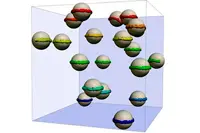Electronics News
Archive : 30 April 2015 год
 The Square Kilometre Array (SKA) Organisation has decided that the permanent headquarters of the SKA project will be the University of Manchester's Jodrell Bank site.
The Square Kilometre Array (SKA) Organisation has decided that the permanent headquarters of the SKA project will be the University of Manchester's Jodrell Bank site.
The ambition is to create a system of distributed radio telescopes whose total collecting area is 1sq km. The SKA is set to provide vast amounts of data to help scientists answer important questions about the universe.
Depending on the frequency selected, the SKA will open the largest ever window on the universe– at frequencies of less than 1GHz, it's likely the field of view will be around 200 square degrees. Because of this, the entire sky will be surveyed more quickly than previously.
The UK plan, backed the UK government via by the Science and Technology Facilities Council, the University of Manchester and Cheshire East Council, as well as Oxford and Cambridge Universities, envisages designing and constructing a campus to meet the needs of the SKA project with space to grow if the project requires it in the future.
To read more about the SKA project: http://www.newelectronics.co.uk/electronics-technology/cover-story-astronomical-data-challenge/72813/
Author
Tom Austin-Morgan
Source: www.newelectronics.co.uk
 An international research team says it has developed a way of making advanced materials that might find application in optical technologies, displays and e-readers.
An international research team says it has developed a way of making advanced materials that might find application in optical technologies, displays and e-readers.
The team, comprising scientists from SISSA, the University of Edinburgh and the University of Padova, introduced flaws into liquid crystals by inserting microspheres and then controlling them with an electric field.
"Generally, flaws are the last thing you want in a liquid crystal," said Giuseppe D'Adamo, a postdoctoral fellow at SISSA. "However, this new method allows us to exploit defects in the material to our advantage." Whilst the optical properties of such composite materials have been attracting attention, the team says the use of electric fields to modify them at will is 'an absolute novelty'.
"Our simulations demonstrate that, by switching on or off an electric field of appropriate intensity, we can reorder the colloids by arranging them into columns or planes," noted SISSA researcher Cristian Micheletti. "This easy to control plasticity could make the material suitable for optical-electronic devices, such as e-readers."
According to the team, the natural tendency of liquid crystal molecules to arrange themselves spontaneously in a certain pattern can be counteracted by introducing colloids in the fluid. "In our case," D'Adamo explained, "we used microscopic spherical particles, which 'force' the molecules coming into contact with their surface to adapt and rotate in a different direction. This creates 'defect lines' in the material which bring a local change in its optical properties."
"By switching the field on and off," Micheletti continued, "we create competition between the spontaneous order of the liquid crystal, the order dictated by the surface of the colloidal particles and, finally, the order created by the electrical potential. This competition produces many defect lines that act on the colloids by moving them or clustering them.
"In this respect, the method works like the electronic ink used in digital readers and it would be interesting to explore its applicability in this sense," Micheletti concluded.
Author
Graham Pitcher
Source: www.newelectronics.co.uk
 STMicroelectronics says its Q1 revenues were $1.7billion, 6.8% less than in Q4 2014 and a similar amount less than revenues in Q1 2014, leading to a loss of $22million.
STMicroelectronics says its Q1 revenues were $1.7billion, 6.8% less than in Q4 2014 and a similar amount less than revenues in Q1 2014, leading to a loss of $22million.
STMicroelectronics says its Q1 revenues were $1.7billion, 6.8% less than in Q4 2014 and a similar amount behind revenues in Q1 2014, leading to a loss of $22million.
Carlo Bozotti, pictured, the company's president and CEO, said: "During the quarter, we saw ST products enabling more and more of the Internet of Things, as well as some of the latest flagship mobile and wearable devices: our AMOLED drivers, touchscreen controllers, pressure sensors, six axis motion MEMS, high performance microphones and STM32 MCUs ramped production or were designed in with global brands in exciting, new devices. The many new industry leading products we introduced during 2014 are steadily increasing our footprint with customers and starting to bring results."
Sales of microcontroller, memory, and secure MCUs provided some encouragement for the company, with a year on year revenue growth of 8%. However, sales of sense and power and automotive products decreased by 6% compared to Q1 2014, something ascribed by ST to lower sales of analogue and mixed signal products. Revenues from the embedded processing solutions business unit decreased by 7.4% over Q1 2014 and by 12% on a sequential basis.
Bozotti noted: "In the second quarter, we expect to increase our revenues by about 3.5% sequentially, with most of our product groups contributing."
Author
Graham Pitcher
Source: www.newelectronics.co.uk

